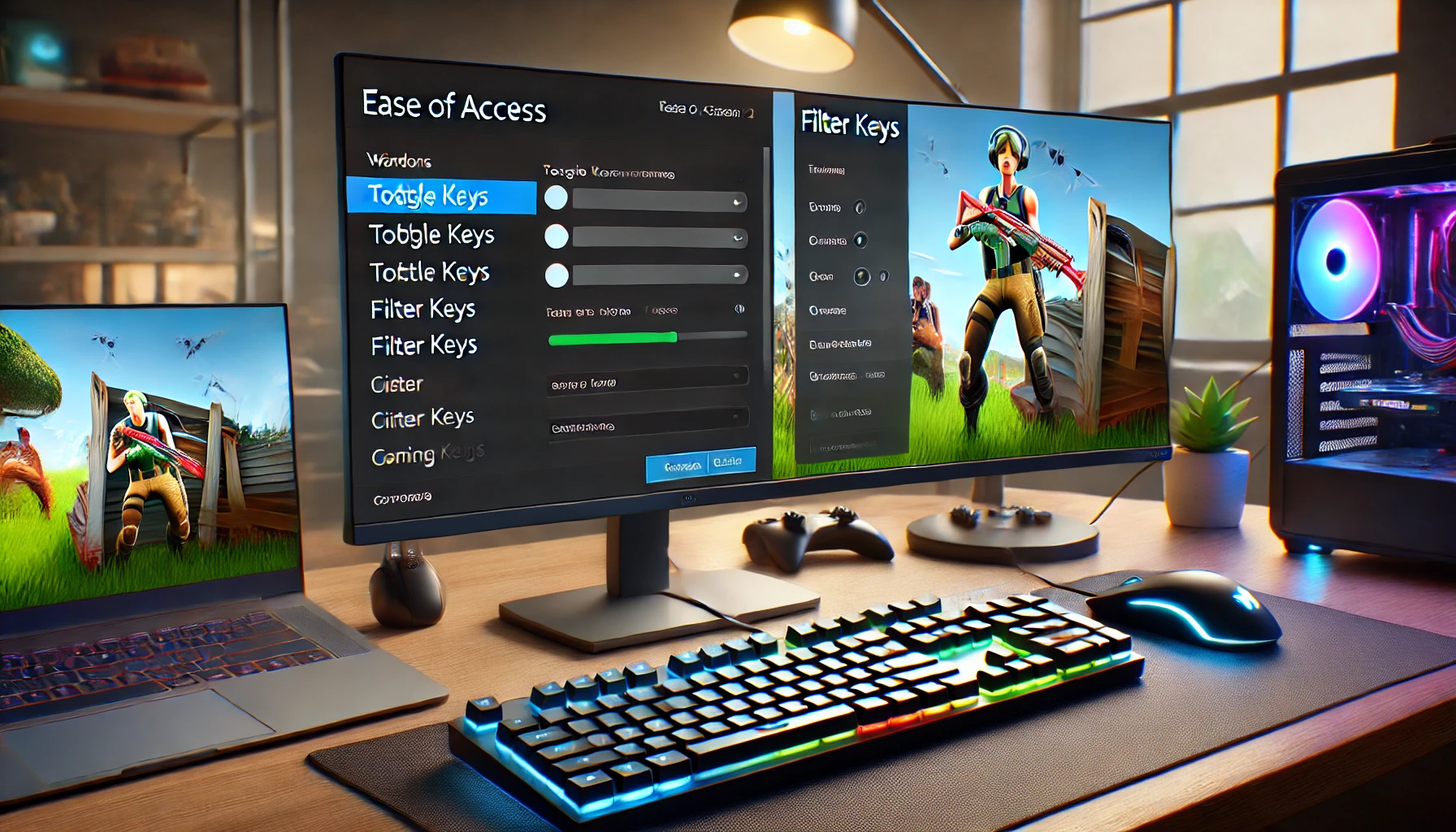In the world of computer accessibility features, Toggle Keys and Filter Keys are two essential tools designed to help users with specific needs. These features, integrated into the Windows operating system, aim to improve the user experience for individuals with physical disabilities or those who require assistance with keyboard input. While both Toggle Keys and Filter Keys serve accessibility purposes, they function differently and cater to distinct needs. This article delves into the differences between Toggle Keys and Filter Keys, their unique benefits, and how they can be utilized effectively. If you are a fortnite player you should definitely checkout this article on How to Use FilterKeys in Fortnite 2024
Understanding Toggle Keys
Definition and Purpose
Toggle Keys is an accessibility feature designed to help users who have difficulty distinguishing between the state of keys like Caps Lock, Num Lock, and Scroll Lock. When enabled, Toggle Keys play a sound whenever these keys are pressed, providing an auditory cue about their status.
How Toggle Keys Work
When Toggle Keys is activated, pressing Caps Lock, Num Lock, or Scroll Lock will generate a high-pitched sound if the key is turned on and a low-pitched sound if the key is turned off. This feature is particularly useful for users with visual impairments or cognitive disabilities who may not notice the small indicator lights on the keyboard.
Enabling Toggle Keys
To enable Toggle Keys on a Windows computer:
- Open Settings: Press
Windows + Ito open the Settings menu. - Ease of Access: Navigate to ‘Ease of Access’.
- Keyboard: Scroll down to ‘Keyboard’ under the ‘Interaction’ section.
- Turn On Toggle Keys: Toggle the switch under ‘Use Toggle Keys’ to enable the feature.
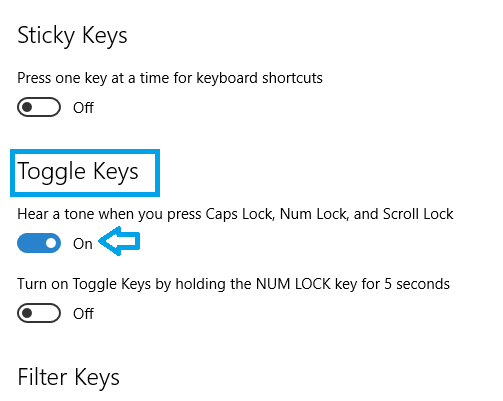
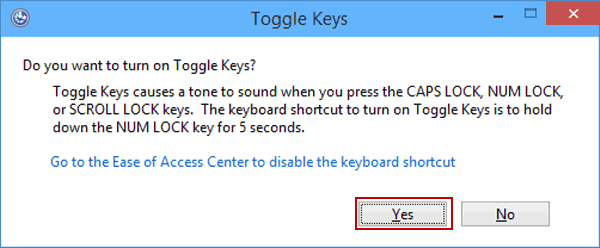
Customizing Toggle Keys
Windows allows users to customize Toggle Keys to fit their specific needs. Some customization options include:
- Sound Notifications: Adjust the volume or type of sound played when a toggle key is pressed.
- Activation Shortcut: Enable or disable the shortcut to turn Toggle Keys on or off quickly by holding down the Num Lock key for five seconds.
Understanding Filter Keys
Definition and Purpose
Filter Keys is an accessibility feature designed to aid users with motor disabilities by modifying keyboard response times. It helps by ignoring accidental repeated keystrokes and adjusting the repeat rate, making it easier for users to type without errors.
How Filter Keys Work
Filter Keys consists of three main components: Bounce Keys, Repeat Keys, and Slow Keys.
- Bounce Keys: This setting helps to ignore repeated keystrokes within a short time frame, preventing accidental double-taps.
- Repeat Keys: Controls how long a key must be held down before it starts repeating and the rate at which it repeats.
- Slow Keys: Adds a delay before a key press is registered, useful for preventing accidental presses.
Enabling Filter Keys
To enable Filter Keys on a Windows computer, Download FilterKeys Setter then :
- Open Settings: Press
Windows + Ito open the Settings menu. - Ease of Access: Navigate to ‘Ease of Access’.
- Keyboard: Scroll down to ‘Keyboard’ under the ‘Interaction’ section.
- Turn On Filter Keys: Toggle the switch under ‘Use Filter Keys’ to enable the feature.
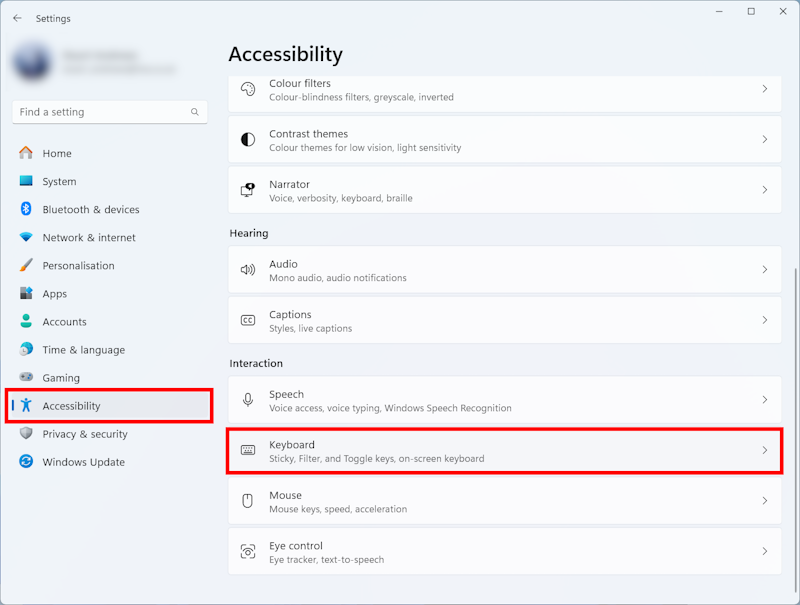
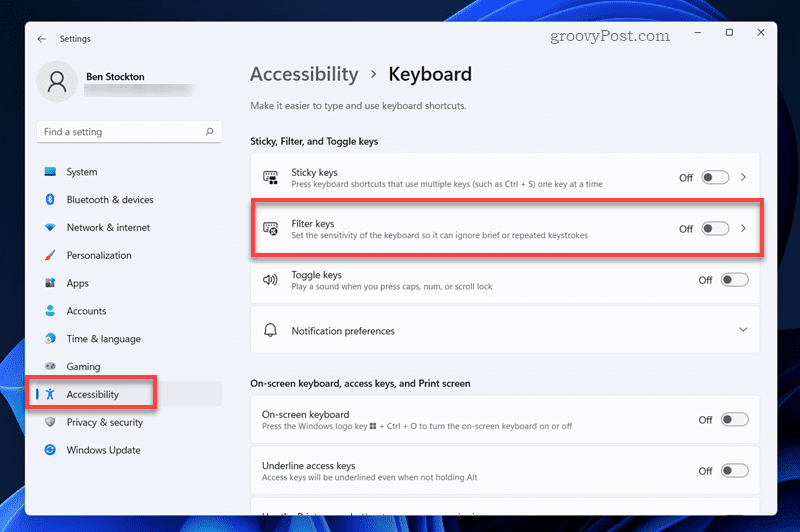
Customizing Filter Keys
Filter Keys settings can be customized to suit individual needs:
- Bounce Keys: Set a delay to ignore repeated keystrokes.
- Repeat Keys: Adjust the repeat delay and rate.
- Slow Keys: Configure the delay before a key press is registered.
Key Differences Between Toggle Keys and Filter Keys
While both Toggle Keys and Filter Keys are designed to assist users with disabilities, they serve different purposes and function in distinct ways.
Purpose
- Toggle Keys: Aims to provide auditory feedback about the status of Caps Lock, Num Lock, and Scroll Lock keys.
- Filter Keys: Focuses on modifying keyboard response times to ignore accidental keystrokes and adjust the repeat rate.
Functionality
- Toggle Keys: Plays a sound when Caps Lock, Num Lock, or Scroll Lock is pressed, indicating whether the key is turned on or off.
- Filter Keys: Includes Bounce Keys, Repeat Keys, and Slow Keys to filter out unintended keystrokes and control key press behavior.
Target Users
- Toggle Keys: Ideal for users who have difficulty seeing or distinguishing the status of toggle keys on their keyboard.
- Filter Keys: Beneficial for users who may accidentally press keys multiple times or have difficulty releasing keys quickly.
Customization
- Toggle Keys: Allows for sound notifications and activation shortcut customization.
- Filter Keys: Offers detailed settings for bounce, repeat, and slow keys to fine-tune keyboard response.
Practical Applications in Everyday Use
Toggle Keys in Daily Use
Toggle Keys can be particularly useful in various everyday scenarios:
- For Users with Visual Impairments: Provides an auditory indication of the status of Caps Lock, Num Lock, and Scroll Lock keys, eliminating the need to look at the keyboard.
- For Users with Cognitive Disabilities: Helps in understanding the state of toggle keys through sound, reducing confusion and errors while typing.
Filter Keys in Daily Use
Filter Keys can significantly improve the typing experience for users with motor disabilities:
- Reducing Typing Errors: Helps prevent accidental double-taps and repeated keystrokes, leading to more accurate typing.
- Improving Typing Speed: By adjusting the repeat rate and ignoring unintended key presses, users can type more efficiently without worrying about errors.
Practical Applications in Gaming
For gamers, especially those playing fast-paced games like Fortnite, the proper use of accessibility features like Toggle Keys and Filter Keys can significantly enhance performance.
Toggle Keys in Gaming
While Toggle Keys may not directly impact gaming performance, it can still be useful:
- Status Awareness: Helps gamers be aware of the status of Caps Lock, Num Lock, and Scroll Lock without taking their eyes off the screen.
Filter Keys in Gaming
Filter Keys can be particularly useful in reducing input lag and preventing accidental keystrokes, which are crucial in fast-paced games like Fortnite:
- Enhanced Precision: Customizing settings to reduce input lag ensures more responsive and precise control during gameplay.
- Preventing Errors: Helps avoid unintended actions by filtering out accidental keystrokes, leading to smoother gameplay.
How to Choose Between Toggle Keys and Filter Keys
Choosing between Toggle Keys and Filter Keys depends on the specific needs and challenges faced by the user.
Consider Your Needs
- For Users with Visual Impairments: Toggle Keys is the preferred choice, providing auditory feedback on the status of toggle keys.
- For Users with Motor Disabilities: Filter Keys is more suitable, as it helps to filter out accidental presses and manage key press behavior.
Experiment and Customize
Both features offer customization options to tailor the experience to individual needs. Experimenting with different settings can help users find the optimal configuration for their specific requirements.
Comparison Table
| Feature | Toggle Keys | Filter Keys |
|---|---|---|
| Primary Purpose | Provides auditory feedback on toggle key status | Modifies keyboard response to ignore accidental keystrokes and adjust repeat rate |
| How It Works | Plays sound when Caps Lock, Num Lock, or Scroll Lock is pressed | Uses Bounce Keys, Repeat Keys, and Slow Keys to filter and adjust keystrokes |
| Ideal For | Users who have difficulty seeing or distinguishing toggle key status | Users who may unintentionally press keys multiple times or have difficulty releasing keys quickly |
| Customization Options | Sound notifications, activation shortcut | Bounce Keys delay, Repeat Keys delay and rate, Slow Keys delay |
| Example Use Case | Providing status awareness of toggle keys through sound | Reducing input lag and preventing accidental keystrokes in fast-paced games |
| Activation | Toggle via Ease of Access settings in Windows | Toggle via Ease of Access settings in Windows |
| Settings Location | Settings > Ease of Access > Keyboard | Settings > Ease of Access > Keyboard |
| Key Components | Caps Lock, Num Lock, Scroll Lock | Bounce Keys, Repeat Keys, Slow Keys |
By incorporating this comprehensive understanding and comparison of Toggle Keys and Filter Keys, users can make informed decisions on which feature best suits their needs, enhancing their overall computing experience.
Conclusion
Toggle Keys and Filter Keys are powerful accessibility features that serve different purposes but both aim to enhance the user experience by making keyboard use more manageable. Toggle Keys is ideal for users who need auditory feedback on the status of toggle keys, while Filter Keys is beneficial for those who require modifications to keyboard response times to prevent accidental keystrokes. By understanding the differences and customizing these features, users can significantly improve their interaction with computers, whether for general use or gaming. Leveraging these settings can lead to a more efficient, comfortable, and enjoyable computing experience.

